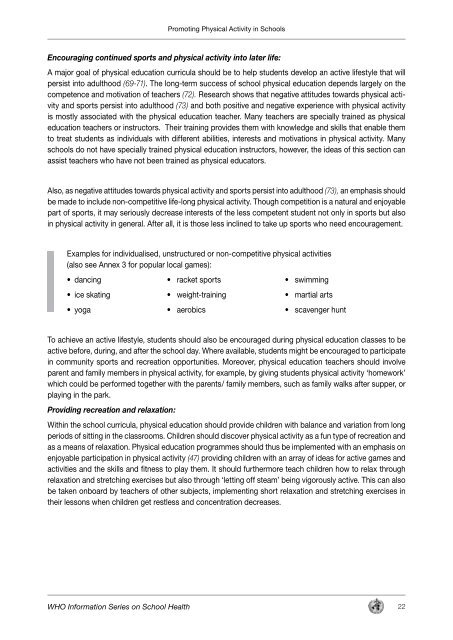WHO INFORMATION SERIES ON SCHOOL HEALTH ... - PAHO/WHO
WHO INFORMATION SERIES ON SCHOOL HEALTH ... - PAHO/WHO
WHO INFORMATION SERIES ON SCHOOL HEALTH ... - PAHO/WHO
Create successful ePaper yourself
Turn your PDF publications into a flip-book with our unique Google optimized e-Paper software.
Promoting Physical Activity in Schools<br />
Encouraging continued sports and physical activity into later life:<br />
A major goal of physical education curricula should be to help students develop an active lifestyle that will<br />
persist into adulthood (69-71). The long-term success of school physical education depends largely on the<br />
competence and motivation of teachers (72). Research shows that negative attitudes towards physical activity<br />
and sports persist into adulthood (73) and both positive and negative experience with physical activity<br />
is mostly associated with the physical education teacher. Many teachers are specially trained as physical<br />
education teachers or instructors. Their training provides them with knowledge and skills that enable them<br />
to treat students as individuals with different abilities, interests and motivations in physical activity. Many<br />
schools do not have specially trained physical education instructors, however, the ideas of this section can<br />
assist teachers who have not been trained as physical educators.<br />
Also, as negative attitudes towards physical activity and sports persist into adulthood (73), an emphasis should<br />
be made to include non-competitive life-long physical activity. Though competition is a natural and enjoyable<br />
part of sports, it may seriously decrease interests of the less competent student not only in sports but also<br />
in physical activity in general. After all, it is those less inclined to take up sports who need encouragement.<br />
Examples for individualised, unstructured or non-competitive physical activities<br />
(also see Annex 3 for popular local games):<br />
• dancing • racket sports • swimming<br />
• ice skating • weight-training • martial arts<br />
• yoga • aerobics • scavenger hunt<br />
To achieve an active lifestyle, students should also be encouraged during physical education classes to be<br />
active before, during, and after the school day. Where available, students might be encouraged to participate<br />
in community sports and recreation opportunities. Moreover, physical education teachers should involve<br />
parent and family members in physical activity, for example, by giving students physical activity ‘homework’<br />
which could be performed together with the parents/ family members, such as family walks after supper, or<br />
playing in the park.<br />
Providing recreation and relaxation:<br />
Within the school curricula, physical education should provide children with balance and variation from long<br />
periods of sitting in the classrooms. Children should discover physical activity as a fun type of recreation and<br />
as a means of relaxation. Physical education programmes should thus be implemented with an emphasis on<br />
enjoyable participation in physical activity (47) providing children with an array of ideas for active games and<br />
activities and the skills and fitness to play them. It should furthermore teach children how to relax through<br />
relaxation and stretching exercises but also through ‘letting off steam’ being vigorously active. This can also<br />
be taken onboard by teachers of other subjects, implementing short relaxation and stretching exercises in<br />
their lessons when children get restless and concentration decreases.<br />
<strong>WHO</strong> Information Series on School Health 22

















